Deutsche Mark facts for kids
The Deutsche Mark (pronounced DOY-chuh Mark) was the official money used in West Germany from 1948 to 1990. After Germany became one country again in 1990, it was still used until 2002. In 2002, Germany, like many other European countries, started using the euro instead. One Deutsche Mark was made up of 100 smaller coins called Pfennig. For a long time, about 1 Deutsche Mark was worth around 0.50 Euros.
Contents
What Was the Deutsche Mark?
The Deutsche Mark was the currency of West Germany and later all of Germany. It was created after World War II to help rebuild the country's economy. This new money helped Germany become economically strong again.
Coins and Banknotes
The Deutsche Mark came in both coins and paper money (banknotes).
- Coins: You could find coins in different values, like 1, 2, 5, 10, and 50 Pfennig. There were also 1, 2, and 5 Deutsche Mark coins.
- Banknotes: The paper money came in larger values, such as 5, 10, 20, 50, 100, 200, 500, and even 1000 Deutsche Mark notes. Each banknote had special designs, often showing important German figures or buildings.
How it Looked
The coins and banknotes of the Deutsche Mark had unique designs. For example, some coins featured the German eagle, a national symbol. The banknotes often showed famous German artists, scientists, or architects. These designs helped people recognize their money and also celebrated German culture.
Why Did Germany Change to the Euro?
In 2002, Germany, along with many other countries in Europe, decided to switch to a new common currency called the euro. This change was part of a bigger plan to make trade and travel easier across Europe.
The Idea Behind the Euro
The main idea behind the euro was to create a single currency for many European countries. This meant that people could travel from one euro country to another without needing to exchange their money. It also made it simpler for businesses to buy and sell goods across borders.
The Transition Period
When the euro was first introduced, there was a short time when both the Deutsche Mark and the euro were used side-by-side. This helped people get used to the new money. After a few weeks, the Deutsche Mark was no longer accepted for payments, and the euro became the only official currency.
Images for kids
-
One Deutsche Mark (1948), first series, Allied military issue
See also
 In Spanish: Marco alemán para niños
In Spanish: Marco alemán para niños




